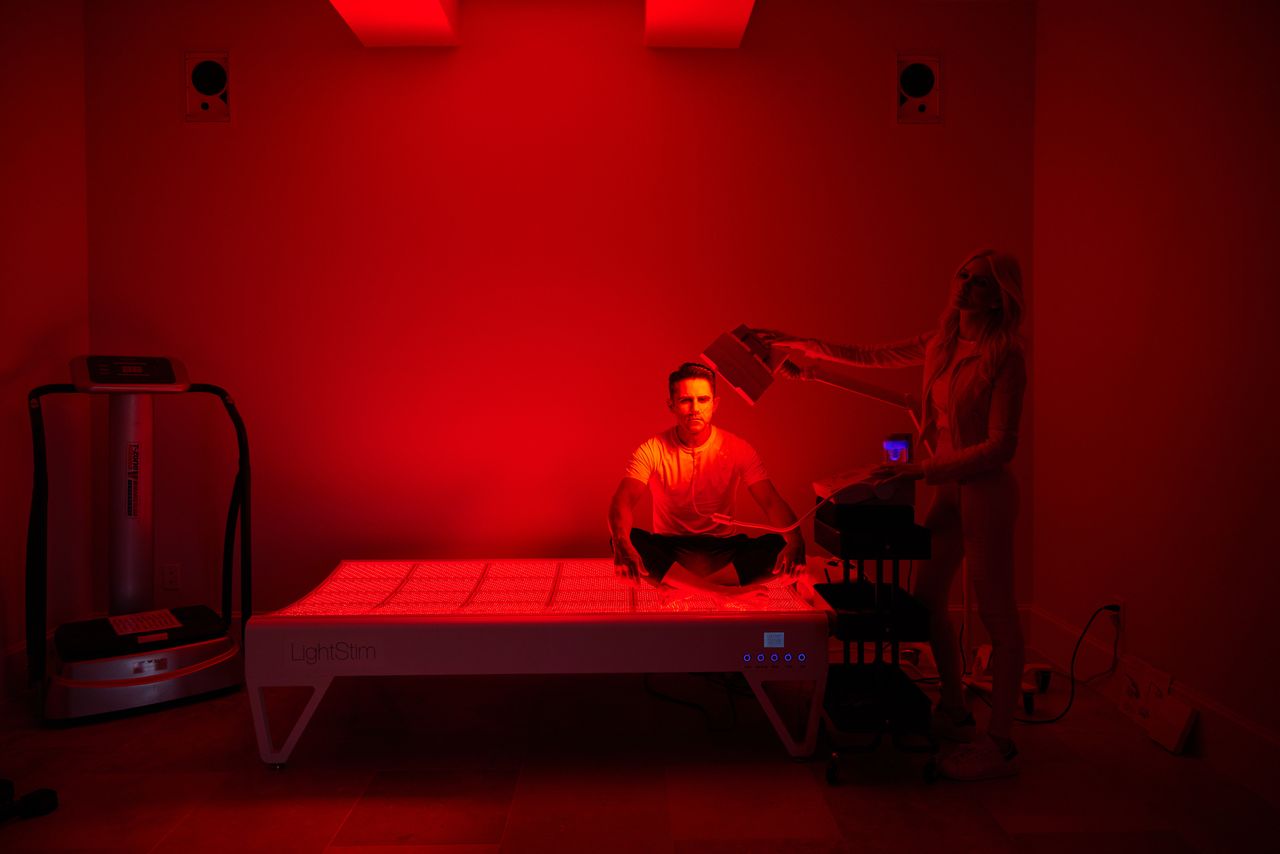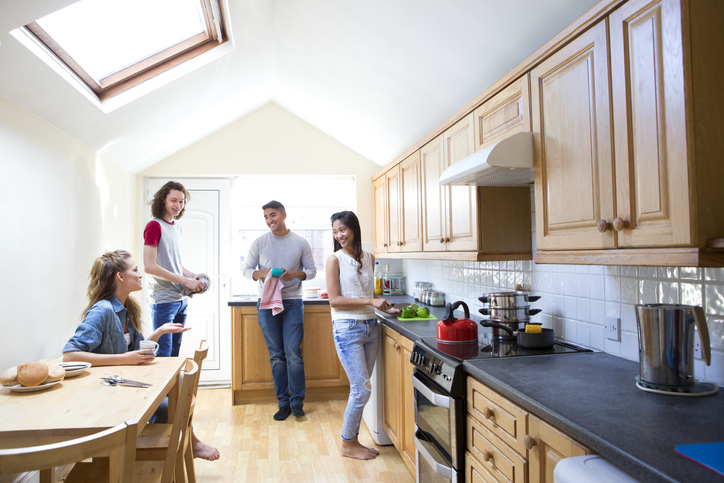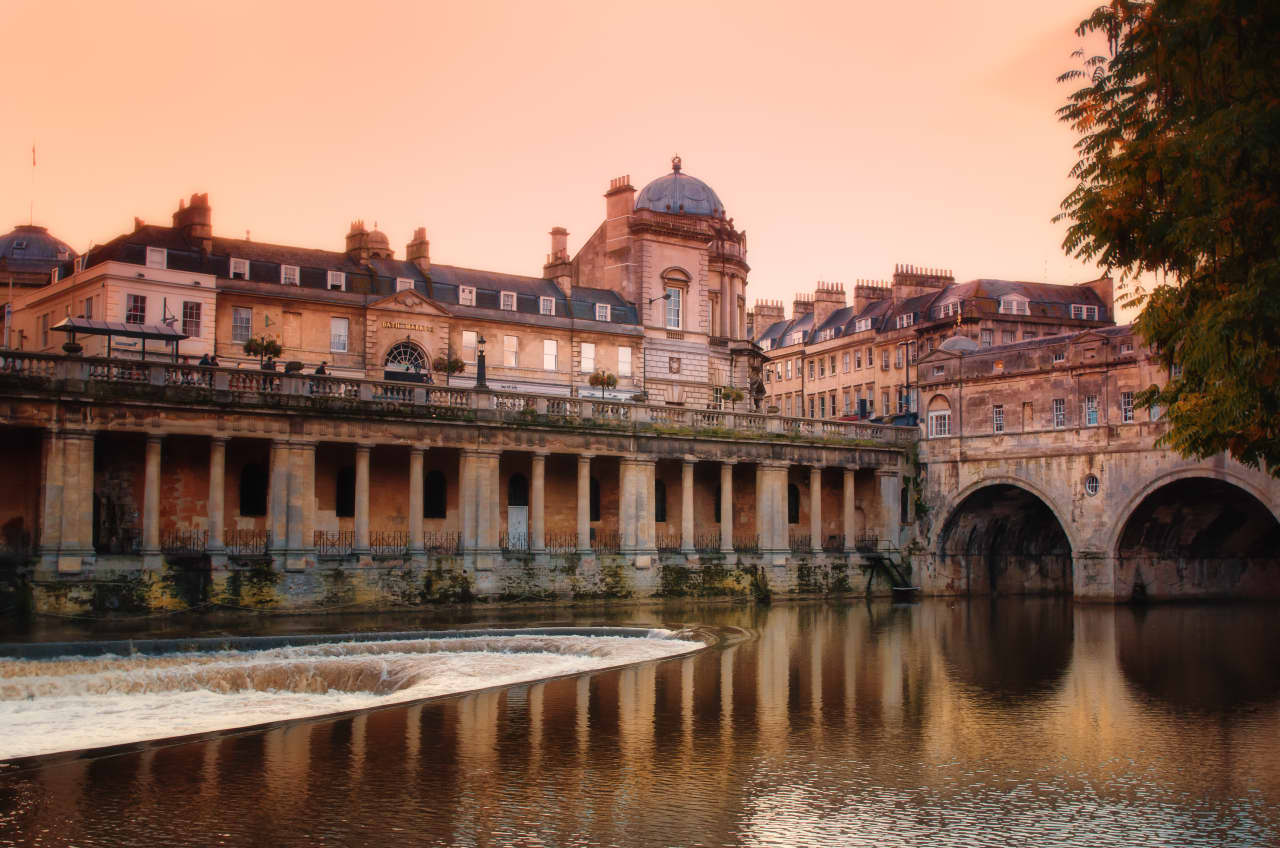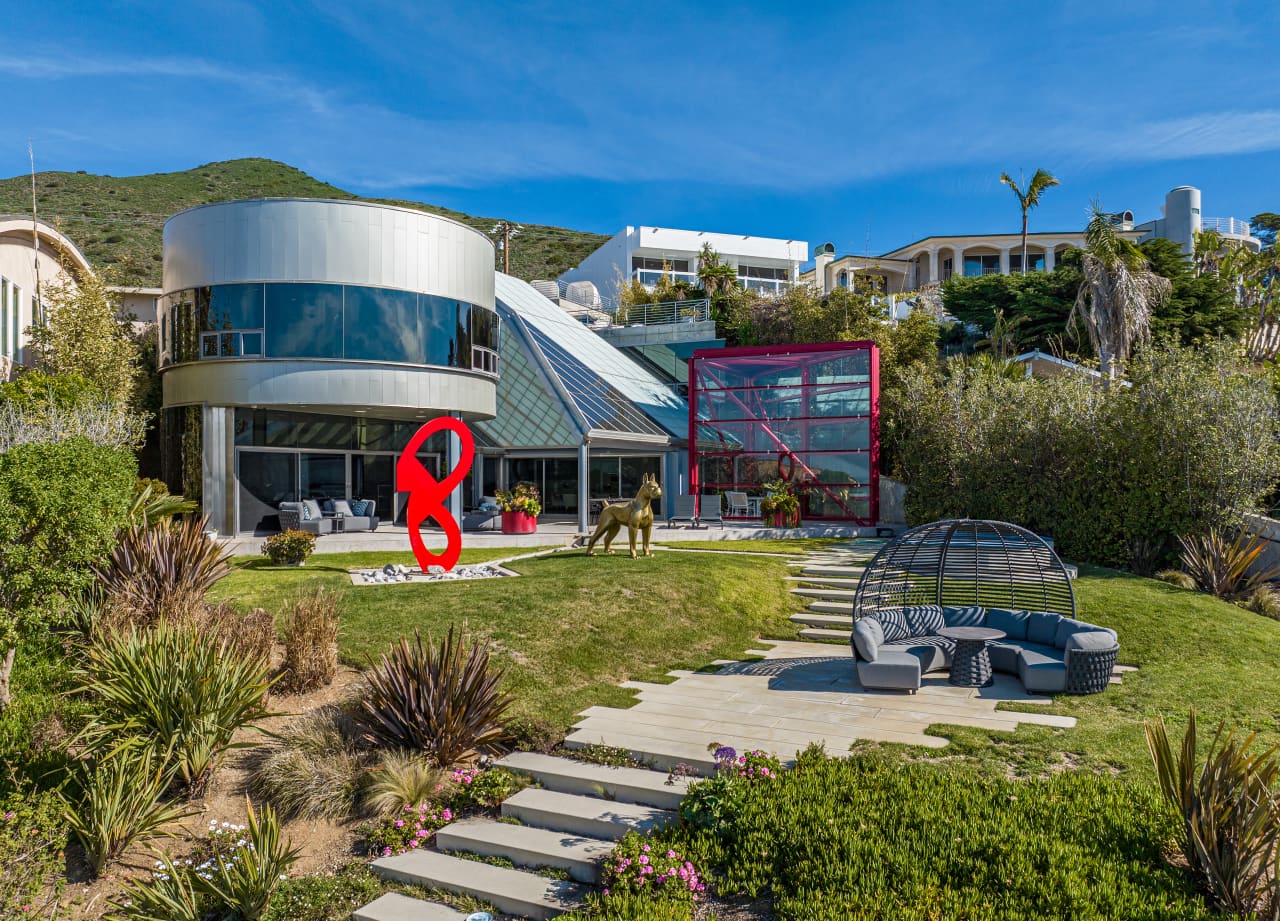The Biohacking Devotees Spending Hundreds of Thousands—Even Millions—to Enhance Their Homes
Light-therapy beds. Infrared saunas. Ozone generators. These homeowners have infused health and wellness into their properties, and then some
Real-estate investors Ari and Kellie Rastegar are devotees of biohacking, a wellness lifestyle aimed at optimising physical and mental performance. He takes 150 custom vitamins and supplements per day; she takes 23. They eat a diet specifically tailored to their genes. They workout with a trainer almost daily. They take posture management classes. They practice Transcendental Meditation. They say affirmations.
But their biohacking isn’t limited to their bodies. They’ve also biohacked their house, an 8,200-square-foot, $22,500-per-month rental in West Lake Hills, Texas, 6 miles from downtown Austin. “Biohacking is part of our life,” says Kellie Rastegar, 37. “You’d have to go out of your way to not biohack in our home.”
Gadgets are strategically positioned throughout their seven-bedroom, eight-bathroom space which they believe will help them achieve peak health and wellness. In the guts of their house are ultraviolet light systems for air and water purification. Their kitchen has a machine that adds hydrogen to their drinking water, providing hydration that Ari Rastegar says is “infinitely more powerful than normal water.” Their bedroom has a mattress pad cooled to 64 degrees Fahrenheit for him and 72 degrees for her. Their gym is outfitted with a machine that pumps extra oxygen into their bodies during training.
There are expensive devices, like a $65,000 light-therapy bed purported to provide training recovery and a $16,990 BioCharger machine that uses light, frequencies and harmonics, voltage and pulsed electromagnetic field technology to, its makers claim, promote cellular rejuvenation, enhance cellular health and revitalise the body. There are inexpensive tools—everything from a $350 inversion table for spinal decompression to $65 toe spacers for improved toe splay and alignment. All in, the Rastegars have spent roughly $135,000 biohacking their house, which they’ve lived in with their three children since 2021. “We’ve never owned our family home, ever,” says Ari Rastegar, noting that he doesn’t know where life is going to take his family. “I want to be able to move at the end of my lease if I want to.”
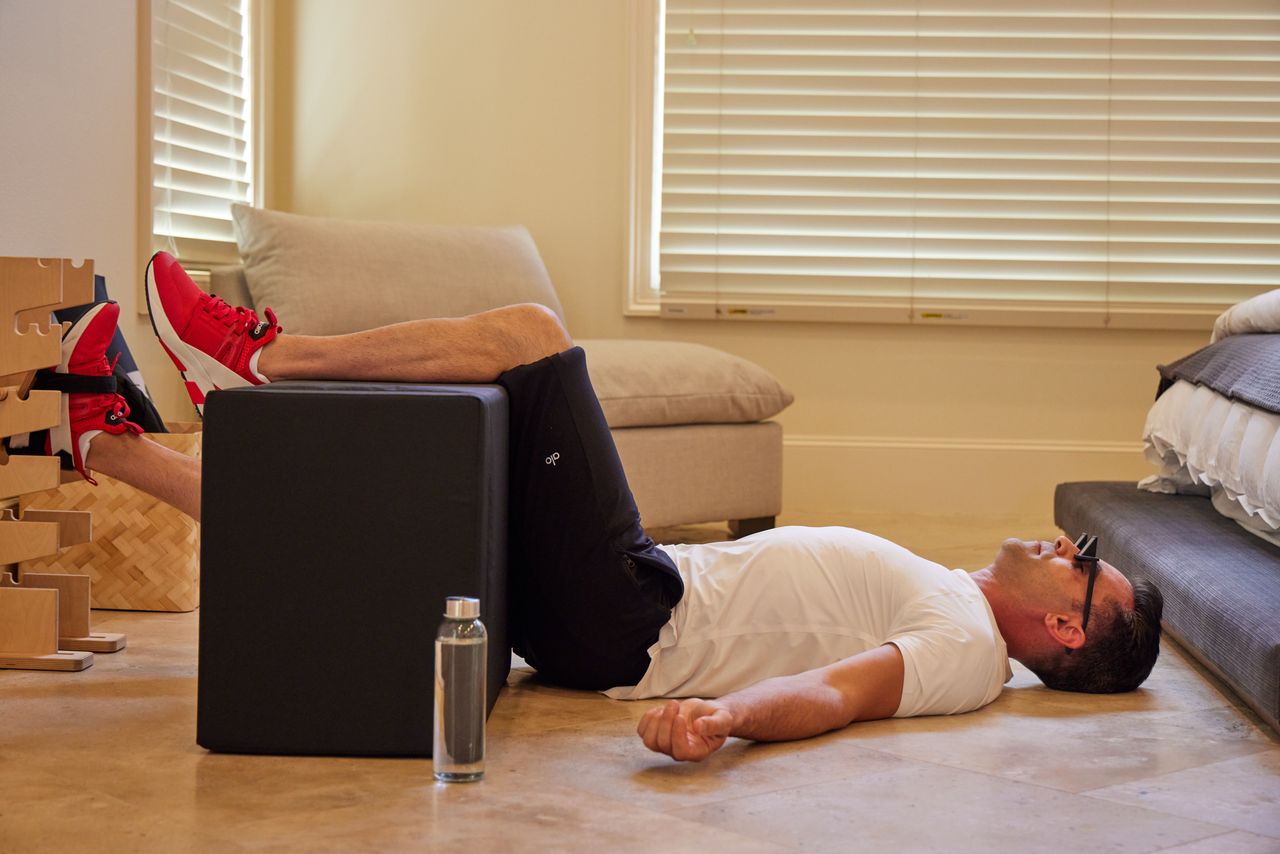
Ari Rastegar, 41, started biohacking around the time he and his wife co-founded Rastegar Property Company, in 2015. He said that his late-night-working, fast-food-eating lifestyle of his 20s and early 30s had caught up with him in the form of thinning hair, dark under-eye circles, weight issues and anxiety. An encounter with neurosurgeon Dr. Jacob Rosenstein changed his course: Rosenstein calibrated the Rastegars’ vitamins, minerals, diet and hormones, which began the couple’s biohacking journey.
Rastegar says adapting his house to support his biology is a necessary response to living in today’s world. “This is about giving myself an extra edge to show up for my kids, my wife, my clients and my staff,” says Rastegar, whose company owns, renovates, manages and develops commercial and residential properties across the U.S. “Does my skin end up looking better or whatever, too? Absolutely. But this is not an exercise in vanity. As an investor, shouldn’t I be asking: ‘How do I remodel me?’ ”
Biohacking became a buzzword around the time Silicon Valley entrepreneur Dave Asprey’s Bulletproof coffee, a.k.a. butter coffee, morphed into an energy-boosting lifestyle in the 2010s. Between then and now, biohacking has become an eclectic umbrella term encompassing everything from sleep journaling to hyperbaric oxygen therapy to human augmentation via device implantation. At the core of all biohacking, however, is one pursuit: Optimisation.
“Biohackers are looking to perform better physically or mentally using hacks,” says biohacking educator Lauren Berlingeri, co-founder of HigherDOSE, which creates at-home, self-care products that support biohacking, including wellness technology like infrared sauna blankets and red-light face masks. Her co-founder, Katie Kaps, describes a hack as receiving a disproportionate gain versus the effort put in. A straight-forward example of a hack, Kaps says, is relieving a bad hangover in 30-minutes with an IV drip.
It is difficult for medical doctors to assess biohacking’s scientific merits and safety due to biohacking’s extremely wide spectrum of tools and interventions. “The bottom line here is that someone familiar with your medical history is best equipped to advise you on whether something is safe for you,” says Dr. Jaclyn Tolentino, a Los Angeles-based senior doctor at the primary care practice Parsley Health. Dr. Tolentino appreciates that biohacking enables self-discovery. “But healthy is a relative term,” she says, noting that whether biohacking starts to veer into unhealthy territory is for each individual and their doctor to decide.
Technology entrepreneur Bryan Johnson, also known as Zero, has a team of doctors overseeing his pursuit as a “professional rejuvenation athlete.” Johnson, 45, through a project he calls Blueprint, is spending $2 million a year experimenting on himself with efforts to slow and reverse ageing. He says his five-bedroom, five-bathroom Los Angeles-area home is set up to support his quest, housing such medical-grade devices as an ultrasound system, skin-therapy devices, skin-measurement systems and infrastructure to collect blood. He also converted the garage into a gym. “It’s a good base camp for building something,” he says of his house, where 25% of his Blueprint experimentation happens; the other 75% takes place at medical facilities.
In north Scottsdale, Ariz., Brian Culhane, 48, and Kristi Culhane, 46, spent $3.5 million building a five-bedroom, six-bathroom house with 10,000 square feet of climate-controlled space. They’ve invested roughly $250,000 on at-home biohacking accoutrements, including a pool, spa, cold plunge, sauna with Himalayan salt, steam room with aromatherapy and light therapy, heated floors, a PEMF bed, an infrared machine and compression boots. Add the indoor basketball court into the tally, and the total biohacking expenditure pushes closer to $1 million.
“We spend quite a bit of money on biohacking, but we have to,” says Brian Culhane, who is the founding agent of cloud-based real-estate brokerage eXp Realty. “It’s keeping me alive. That’s how we look at it.”
In 2011, Culhane broke his hip in a bicycling accident. Thus began a long, circuitous and still-ongoing hip rehabilitation nightmare, which, in 2018, led him to start training with Troy Casey, a longevity guru based in Scottsdale, Ariz. Culhane says he inspired him to fully delve into biohacking. Culhane began traveling the world—at first by himself, and later with his wife—meeting with biohacking experts and visiting spas, until he had a realization. “I wanted to build a house into a huge training centre and bring everyone and everything to me,” he says.
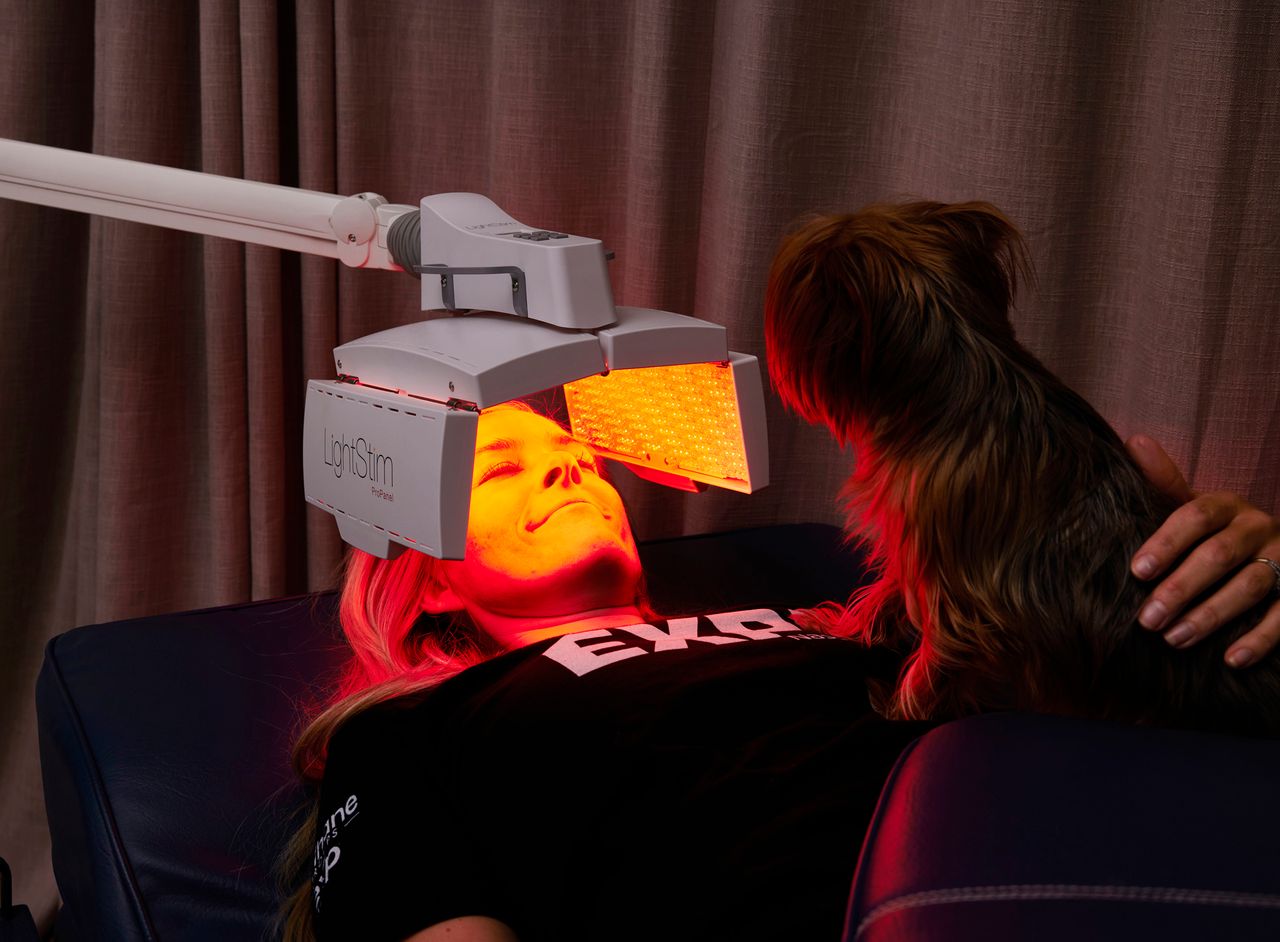
The Culhanes were sitting on a 1.1-acre land parcel they bought in 2018 for $546,500. In 2020, the Culhanes started building a spa-like, biohacking dream house. The project persevered through Covid-19 pandemic curveballs like difficulty getting a construction loan, the lumber shortage and the supply chain crisis—plus the couple’s own stock-portfolio fluctuations—before the Culhanes, who have three children, finished construction in late 2022.
Brian Culhane’s biohacking protocol varies day-to-day. Some days he might lie in his PEMF bed while using infrared light, wearing compression boots and receiving supplemental oxygen and IV nicotinamide adenine dinucleotide (NAD) drips—a combination that leaves him, he says, “feeling jacked.” Other days, he might engage in at-home ozone therapy or stem cell shots.
Everyday, however, Culhane aspires to do the same morning routine with his wife, which includes waking up at 4:45 a.m. followed by praying, meditating and doing thought projecting; making the bed and drinking a half-cup of coffee; taking amino acid supplements; honouring the morning sunrise; doing a 30- to 45-minute workout or heavy qigong; taking a 10-minute, very hot 194 degree Fahrenheit sauna while doing breathwork; taking a 3- to 5- minute, very cold 39 degree Fahrenheit cold plunge; taking a 3- to 5- minute hot-tub dip; taking a 3- to 5- minute steam while doing breathwork focused on vocal vibrations and lymphatic draining; rinsing off in the cold plunge; drinking a green shake and taking prebiotics and more supplements; getting the kids off to school by 7:45 a.m.; doing some kind of movement like going to the gym, walking, hiking, or biking; and, finally, recovering.
“Why not build a house where you can do these things?” Brian Culhane asks. “You spend so much time at home. Your house should heal you. It should nourish you. It should rejuvenate you. It shouldn’t kill you.”
At a basic level, biohackers are onto something: Air quality, water quality and light are the top elements of indoor wellness as validated by the WELL Building Standard, a global certification used to assess a building’s effect on occupant health. The standard was launched in 2014 by New York-based company Delos and backed by research contributed by such institutions as Mayo Clinic and Cleveland Clinic. The company’s founder and CEO Paul Scialla says sufficiently improving indoor air, water and lighting can be done for 1% of construction costs or less. “It doesn’t have to break the bank,” he says.
Considering the built environment is the approach Luke Storey, 52, took when he and his wife, Alyson Charles Storey, 44, gut renovated their 3,500-square-foot house in Texas Hill Country, about 30 minutes from downtown Austin. Storey says people call him a biohacker even though he doesn’t like the word. “The term has a reductionist, mechanistic view of the body and a person’s relationship with it,” says Storey, who is a wellness expert, spiritual guide and the Life Stylist Podcast host. “I relate to my body as an intelligent organism, but there isn’t a catchy term for that.”
The Storeys bought their now five-bedroom, three-bathroom space for $865,000 in 2021. During inspection, they discovered a dreaded wellness foe: Mould. It required the demolition of the bathroom sinks, laundry room and kitchen sink. The Storeys had been considering a less-substantial renovation, but in remediating the mould, they decided to dream bigger and to spend $500,000 creating what Storey calls a sacred healing temple.
Storey estimates there is about $150,000 in biohacking technology in the house, including an ice bath, two infrared saunas, a hydrogen water machine, a molecular hydrogen gas generator, a red-light-therapy machine, an ozone generator and PEMF devices. But making room for equipment was a secondary renovation objective. The primary goal was to replicate the natural world indoors as much as possible, what Storey refers to as creating an ancestral environment.
There are air purifiers in the HVAC system and around the house. Water goes through two purification systems; there is a separate drinking water station. White-blue light bulbs are used during the day to mimic the full spectrum of sunlight, and at night, only amber incandescent or solid red light bulbs are used—this includes orange or red landscape lighting to protect animals. There is red tape on every in-home blue light source, such as inside the fridge. Electromagnetic field (EMF)—invisible areas of energy—is reduced with ethernet wiring, WiFi with a manual on-off, an EMF kill switch in the main bedroom, EMF mitigating paint and EMF-harmonising devices and quantum energy generators.
Storey concedes that not all houses need all these things. “I go the extra mile because I’m just extra, that’s who I am,” he says. “A lot of this might sound crazy or extreme to some people.”
“To me,” he adds, “this is just basic biology.”
 Copyright 2020, Dow Jones & Company, Inc. All Rights Reserved Worldwide. LEARN MORE
Copyright 2020, Dow Jones & Company, Inc. All Rights Reserved Worldwide. LEARN MORE
This stylish family home combines a classic palette and finishes with a flexible floorplan
Just 55 minutes from Sydney, make this your creative getaway located in the majestic Hawkesbury region.
The housing crisis could be addressed without the need for more dwellings, the RBA assistant governor says
The Reserve Bank assistant governor says how we live now is contributing to the housing shortage.
The National Housing Accord announced by the Albanese Government aims to build 1.2 million new well located homes over the next five years, starting from 1 July. The Accord is an agreement between the Federal Government and the states and territories to work together to raise the supply of homes. It begins with $3.5 billion in federal funding and the states and territories undertaking expedited zoning, planning and land releases to facilitate new building.
All of this is happening amid a housing crisis that has seen rents and home values both skyrocket by more than 40 percent since August 2020, according to CoreLogic data. Demand for social housing is also high, while post pandemic immigration has put further pressure on the market, and dwelling approvals per capita are at decade-lows amid high interest rates and higher materials and labour costs.
But there’s another way to fix it, says RBA assistant governor Sarah Hunter. We could just go back to living like we did in the 1980s. Back then, households were larger in size. That is, the number of people per household was higher at 2.8 people per home compared to 2.5 now. That may not sound like much of a difference, but Ms Hunter says if we reverted to this we’d need 1.2 million fewer homes right now.
In a speech last week on housing market cycles and fundamentals, Ms Hunter said that underlying demand for housing – be it rental or ownership – is determined by the size of our population, currently 27 million, and the average number of people living in each of our 11 million homes.
Ms Hunter said Australia typically has faster population growth than other advanced countries, driven by net overseas migration. In FY23, new overseas migration totalled more than half a million people. She also said the size of Australian households has been trending lower over the long term, mainly due to demographic factors. These include an ageing population, which means we have more elderly Australians living alone or in couple-only households; as well as a falling birth rate, which is reducing the average family size.
While the demographic trends that drive housing demand tend to occur slowly, the pandemic sped them up. “During the pandemic, there was a shift in preferences towards more physical living space per person ... This was particularly the case for people who shared a home with non-family members, such as young people living in a flat share,” Ms Hunter said. “This group shrank as a proportion of households, while the share living with their partner increased – as a result, the average household size declined.”
She added: “The shift to working from home has also reinforced this change. While some people have returned to their workplace full time, there has been an increase in the proportion of people working from home – for many, a home office space is now highly desirable. This suggests that the recent falls in the average number of people per home will be at least partially permanent.”
When housing demand rises, supply usually responds through new building activity. But the time this takes can vary, depending on rental and housing prices, underlying construction costs and the time required to design, approve and build. In the meantime, property prices and rents adjust in line with the extent of the demand and supply imbalance.
“The pandemic period – and its aftermath – stands out as a particularly sharp cycle,” Ms Hunter said. Growth in demand for new dwellings slowed rapidly in 2020 before rebounding strongly, partly due to the HomeBuilder program. But supply did not respond normally, with completions trending lower over the past five years due to a “perfect storm” of challenges in the construction sector.
They began with COVID-related supply chain disruptions that made it difficult to source materials, fixtures and fittings. Materials and labour costs went up, and a combination of shipping delays and labour shortages significantly extended building timelines. Today, supply chains have normalised but costs remain nearly 40% higher than in 2019 and the pipeline of new builds is clogged.
Additionally, major new projects are typically funded by debt, so higher interest rates are also reducing the viability of new builds. Many developers have delayed projects because of higher costs relative to anticipated returns. Meriton founder Harry Triguboff recently told The Australian that government and council approvals take too long and “it is harder to sell apartments now than ever before” due to high interest rates and fewer Chinese buyers.
Ms Hunter said easing zoning and planning restrictions and streamlining approval processes could reduce costs and lift supply but “it will not be a quick fix”. She concluded: “… upward pressure on rents and prices will remain until new supply comes online”.
This stylish family home combines a classic palette and finishes with a flexible floorplan
Just 55 minutes from Sydney, make this your creative getaway located in the majestic Hawkesbury region.









